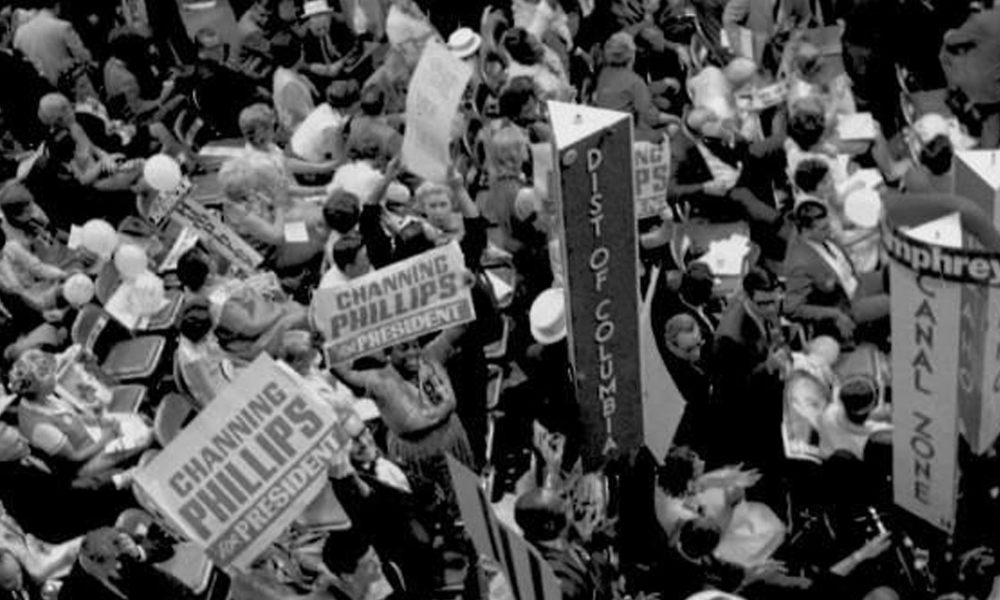Every year, Rabbi Arthur Waskow, a leader in the Renewal movement, tells this story to his many followers on Thanksgiving. Moment first published this story in our September/October 2000 issue.
I came to understand the power of a yarmulke during the Chicago Eight trial. The chain of events that led to that epiphany began two years earlier in 1968. I was an alternate delegate from the District of Columbia to the Democratic National Convention in Chicago—elected as part of an antiwar, antiracist slate backing Robert Kennedy. After Kennedy’s murder, we decided to nominate and support the Rev. Channing Phillips {alav hashalom), a black minister in the Martin Luther King, Jr. mold. (Our delegation made him the first black person ever nominated for president at a major-party convention.) I addressed the antiwar demonstrators in Grant Park while the Chicago police and National Guard menaced them. The police finally exploded in violence on the third night, when the crowd tried to march peacefully toward the convention hall during the balloting.
Although the official investigation described the ensuing melee as a “police riot,” the Nixon administration decided to indict the antiwar leaders. The Chicago Eight defendants (it was later reduced to seven defendants when Black Panther Bobby Seale was sent to prison for contempt), including Tom Hayden, David Dellinger, and Abbie Hoffman, figured that since I had been a delegate, I would make a reasonably respectable witness on their behalf. The U.S. government had charged them with conspiracy to organize a riot and destruction. My job was to convince the jury that the protesters were not trying to incite the violence.
As the trial went forward, it became clear that Judge Julius Hoffman, a deeply assimilated Jew, was utterly subservient to the prosecution and wildly hostile to the defense. Hoffman’s chief Jewish involvement was membership in a super-fancy Jewish city club, created because Chicago’s other men’s clubs blacklisted Jews.
So when I arrived at the federal courthouse, I was more than a little nervous. Arlo Gudirie, who had sung “Alice’s Restaurant” to the crowd at Grant Park, was scheduled to testify before me. The defense wanted to show the jury that die rally was a peaceful one. When Guthrie took the stand, defense lawyer William Kunsder asked him to sing the song. Judge Hoffman stopped him. “You can’t sing in m y courtroom!” he said. “But,” replied Kunstler, “it’s evidence of the intent of die organizers and the crowd.”
“He can say what he told them,” the judge thundered, “but no singing!”
Only, Guthrie couldn’t do it. He knew the 25-minute song by heart. H e had sung it thousands of times. But when asked to say it without singing it, he drew a blank. His memory was keyed to the melody. And perhaps Judge Hoffman’s glare unnerved him. Guthrie went back to the witness room, crushed.
Meanwhile, I was up next. I remember trembling, trying to figure out how I could avoid falling apart. And then I came up with a solution. I had never before worn a yarmulke in a nonreligious setting. But I decided that if I wore a kippah it would strengthen my connection to a power much higher than Judge Hoffman.
“I want to weat my yarmulke,” I told Kunstler.
“No problem,” he answered.
I rustled up a simple black skullcap, and when I went to be sworn in, I put it on. While I was being sworn in (which I did as an affirmation, as indicated by much of Jewish tradition), it was no problem.
But when Kunstler asked m e the first question, Hoffman interrupted: “Take off your hat, sir,” he said.
Kunstler erupted. ” This man is an Orthodox Jew!” (I moaned to myself. One thing I was not was an Orthodox Jew.)
But Judge Hoffman was not swayed. “That hat shows disrespect for the United States and this honorable court!” A shouting match ensued. I watched the prosecutor, w h o was watching the jury. There was one Jewish juror. What was the juror thinking? Finally, the prosecutor addressed the judge. “Your Honor, the United States certainly understands and agrees with your concern, but we also feel that in the interests of justice, it might be best simply for the trial to go forward.”
And, incredibly, the judge agreed. He shut up, and the rest of my testimony was quiet and orderly.
It took me another year or so to startwearing some sort of hat all die time. For years, it was a Tevye cap. For years, and some of the time now, a beret. Sometimes, a rainbow kippah. Sometimes in a rough winter, a tall Tibetan hat with earflaps and wool trimming. And what die hat continues to mean to me is that there is a higher, deeper truth in the world than any judge or pharaoh.
Top image: Delegates from Washington DC at the 1968 Democratic National Convention. Courtesy of the National Archives.

